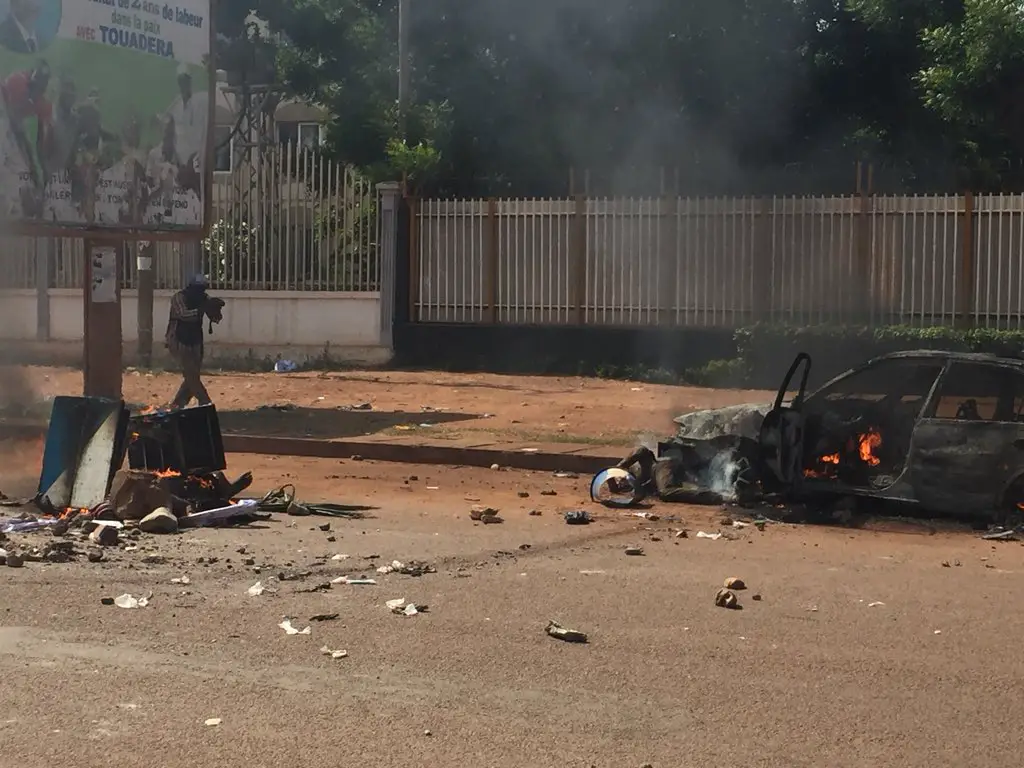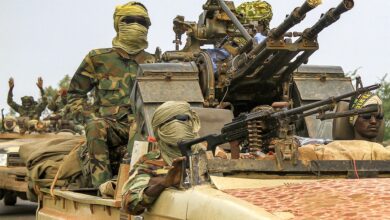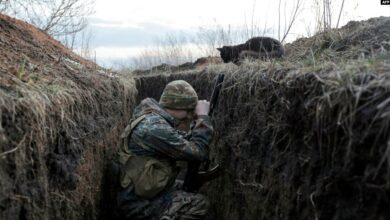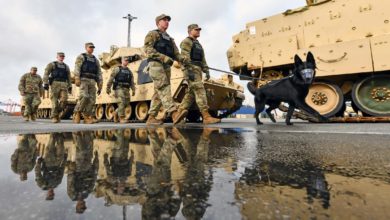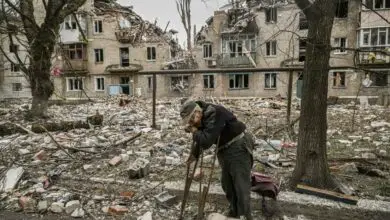Large protests were continuing on Wednesday after at least 16 people were killed and nearly a hundred wounded in clashes including between militia and security forces in the capital of the Central African Republic.
Hospital sources said at least 16 people died on Tuesday, including a priest and a child, while 96 people were being treated for wounds, AFP reported. Some unconfirmed reports say more than 25 people were killed.
Update May 2 According to AFP, a revised toll indicates at least 24 people died, and around 170 people were wounded.
The priest was named as Toungoumale Baba, who died in the Fatima district, a church source said. There were no immediate details about the circumstances of his death.
https://twitter.com/pacomepaba/status/991311296611090433
The exact sequence of events, and what may have begun the spiral of violence is unclear.
Security sources in Bangui’s mainly Muslim PK5 district said a shootout started after men in a militia group led by a man known as “Force” rammed through a roadblock, AFP reported.
According to a statement from the United Nations Minusca mission on Tuesday, “Central African internal security forces exchanged fire with armed elements” of the Force group, “after a member of the criminal group was arrested by the internal security forces.”
Minusca said it “immediately deployed reinforced patrols to secure key locations in Bangui in close cooperation with the internal security forces.”
Reports from earlier Tuesday said that shots were fired in an attack on the Notre Dame de Fatima church blamed on PK5 militia members.
In a Tuesday statement, the U.N. Humanitarian Coordinator for CAR Najat Rochdi said Father Albert Tougoumalé-Baba died “following the attack on the Fatima Church in the 6th district of Bangui, while presiding over a mass to mark the St Joseph Day.”
In a Wednesday statement, government spokesperson Angel Maxime Kazagui said that “armed criminals threw a grenade” into the church grounds, killing and injuring many. This was followed by gunfire and Toungoumale-Baba and several parishioners “were affected mortally.”
Update May 2 Portuguese U.N. personnel were involved in the clashes at the church, a May 1 statement from the country’s armed forces said.
Portuguese paratroopers attached to Minusma in Bangui were activated at about 11:45 a.m. to respond to reports of an exchange of fire at the Notre Dame de Fatima church, the statement said.
When they arrived, several shots were fired at them from small arms, and they then organised defensively in the church along with other Blue Helmets and some local police officers. The Portuguese personnel executed “fire and movement” to secure the area.
La Libre reported that the attack on the church was in retaliation for the arrest of the member of the Force group.
Civilians were killed and U.N. personnel and vehicles were attacked in several neighborhoods of Bangui, the U.N. mission said.
Two Minusca members were attacked in the PK0 institutional district, according to U.N. sources, La Libre reported.
#Centafrique #1erMai2018 dblement endeuillé/attaque #ÉgliseCatholique #NotreDameFatima & répression manifestation population convoyage dépouille #AbbéToungoumaléBaba vers #PalaisRenaissance à #PlaceDeLaRépublique (#PK0)/#PouvoirTouadéra. @touaderafaustin fait guerre au #Peuple pic.twitter.com/BRwS9uT9mm
— Henri GROTHE (@grothe2) May 1, 2018
Minusca also sent a patrol to the district of Lakouanga, where a mosque was set on fire by demonstrators, Minusca spokesperson Vladimir Monteiro told AFP.
Graphic images were shared on social media purportedly of people who were burned to death in the mosque. The Defense Post cannot confirm the veracity of the information shared. La Libre reported a medical source as saying that that two people suspected of being Muslims were lynched in Lakounga.
Medical charity Medecins Sans Frontieres (Doctors Without Borders) said SICA Hospital had received more than 50 people with bullet wounds “following the exchange of fire and a resurgence of violence in the PK5 and Fatima districts.” Six injured people died of their wounds.
MSF said a crowd gathered at the entrance to the hospital, blocking ambulance access, and appealed for “hospitals to be respected,” regardless of individual religious or political affiliations.
#CARcrisis #URGENT #centrafrique : la situation se dégénère à Bangui.Le corps de l'Abbé Toungoumalé Baba tué par grpes armées du KM5 est transporté par la foule en direction du Palais présidentiel. La population demande en urgence au Président Touadera une solution securitaire. pic.twitter.com/b2jiOUUk1J
— Emery Elvis PABANDJI (@emerypabandji) May 1, 2018
“This is not an operation against communities”
Tuesday’s incidents came after clashes in PK5 between April 8 and 11 in which dozens of people including a U.N. peacekeeper were killed and more than 100 were wounded.
According to Minusca, the fighting began when a joint patrol of Rwandan U.N. troops and the Central African army was attacked on the district’s outskirts during its Operation Sukula action against armed groups in the PK5 enclave.
In a dramatic protest, local people brought 17 bloodied corpses with bullet wounds and laid them in front of the U.N. base in the centre of Bangui. They said those who died were simply unarmed civilians, a version of events contested by Minusca, which is struggling to overcome accusations of inaction and sexual abuse by some of its troops in the past.
Spokesperson Vladimir Monteiro has repeatedly said Minusca troops targeted criminal gangs during the operation.
“This is not an operation against communities and specifically the Muslim community. The Muslim community asked our troops to launch the operation and put an end to the criminal activities,” he said on April 11.
Within days of the events in PK5, heavily armed ex-Seleka faction members began regrouping in several towns in northeastern CAR, notably in Kaga Bandoro, around 350 km from Bangui.
The FPRC – the Popular Front for the Rebirth of Central Africa, one of the country’s largest armed groups – threatened to march on Bangui. The group said it wanted to act following Operation Sukula, saying that it singled-out Muslims.
On April 25, FPRC spokesperson Aboubakar Sidik Ali said dicussions with other ex-Seleka factions were ongoing and that the option to move on the capital remains “on the agenda, since the government said the operation will continue.” The FPRC “must protect” the civilian population, Ali said.
A country beset by sectarian and ethnic violence
Resource-rich but one of the world’s poorest and most unstable countries, the recent unrest Central African Republic began after Francois Bozize was overthrown in 2013 by the mainly Muslim Seleka rebel alliance.
Within months, Seleka was officially disbanded, but many fighters refused to disarm, becoming known as ex-Seleka. Many others joined the mainly Christian anti-balaka militia to fight the Seleka, leading to a spiral of violence between groups along both religious and ethnic lines in which thousands died.
By the end of 2014, the country was de facto partitioned – anti-Balaka in the southwest and ex-Seleka in the northeast.
President Faustin Archange Touadera, a former prime minister who campaigned as a peacemaker, was declared the winner of a 2016 presidential election perceived as crucial to transitioning from years of sectarian violence.
His weak government now only controls around a fifth of the Central African Republic and relies heavily on Minusca for support. The rest is controlled by at least 14 different militia groups who often fight each other for control of revenue from extortion, roadblocks or mineral resources.
Last week, Touadera said he wants to “accelerate” the disarmament of members of armed groups in Central African Republic, and for the U.N.’s Minusca mission to transition from peacekeeping to peace enforcement.
Minusca is one of the most dangerous U.N. peacekeeping missions.
According to a February report to the U.N. Security Council, Minusca had deployed 10,665 military personnel, 90 percent of the total authorized strength of 11,650, as well as 2,044 police and 1,390 civilian personnel.
Last week, Ivory Coast said it will send 450 troops to serve as peacekeepers. The U.N. is also seeking 900 extra troops to bolster Minusca, which the Security Council authorized in November.
On April 22, four people were killed in clashes between U.N. peacekeepers and the Siriri armed group in southwest CAR, an area spared much of the violence that has ravaged the country since 2013. On April 2, one U.N. peacekeeper from Mauritania was killed and 11 others were wounded and more than 22 anti-balaka fighters were killed when a temporary U.N. base in Tagbara came under heavy militia attack.
Central African Republic: Ex-Seleka militias regroup as president urges shift in UN posture
With reporting from AFP

